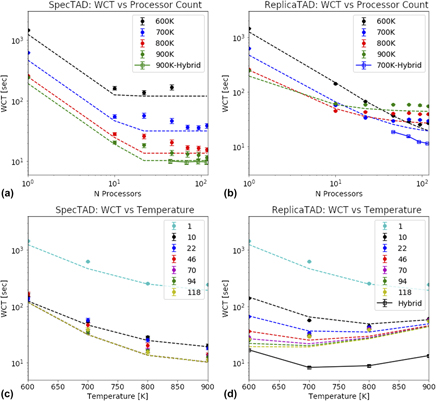Article contents
Speculation and replication in temperature accelerated dynamics
Published online by Cambridge University Press: 12 February 2018
Abstract

Accelerated Molecular Dynamics (AMD) is a class of MD-based algorithms for the long-time scale simulation of atomistic systems that are characterized by rare-event transitions. Temperature-Accelerated Dynamics (TAD), a traditional AMD approach, hastens state-to-state transitions by performing MD at an elevated temperature. Recently, Speculatively-Parallel TAD (SpecTAD) was introduced, allowing the TAD procedure to exploit parallel computing systems by concurrently executing in a dynamically generated list of speculative future states. Although speculation can be very powerful, it is not always the most efficient use of parallel resources. Here, we compare the performance of speculative parallelism with a replica-based technique, similar to the Parallel Replica Dynamics method. A hybrid SpecTAD approach is also presented, in which each speculation process is further accelerated by a local set of replicas. Overall, this work motivates the use of hybrid parallelism whenever possible, as some combination of speculation and replication is typically most efficient.
Keywords
- Type
- Article
- Information
- Journal of Materials Research , Volume 33 , Issue 7: Focus Issue: Advanced Atomistic Algorithms in Materials Science , 13 April 2018 , pp. 823 - 834
- Copyright
- Copyright © Materials Research Society 2018
Footnotes
This author was an editor of this journal during the review and decision stage. For the JMR policy on review and publication of manuscripts authored by editors, please refer to http://www.mrs.org/editor-manuscripts/.
Contributing Editor: Enrique Martinez
References
REFERENCES
- 5
- Cited by



